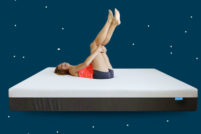Choosing your mattress size is one of the first decisions you’ll need to make when buying a new bed and there are a number of considerations that should be taken into account when you’re browsing.
While it can be easy to pick a bed size and stick with it, our needs change as we grow, sleeping preferences change, and the space you have available can have a big impact on what size bed is best for you.
To help you make the best decision for you and your sleeping arrangements, we’ve put together a guide to all the different bed sizes and their measurements, as well as a few key things you may need to bear in mind when choosing your new bed.
Bed Size Guide:
| Size: | Dimensions (in inches): | Ideal for: |
| Small Single/Cot: | 30 x 75 | Babies and Toddlers. |
| Twin | 38 x 75 | Children and single adults. Perfect smaller size for bunk beds, day beds and small rooms. |
| Twin XL | 38 x 80 | Children and taller adults. Best size for split adjustable bed frames. |
| Full | 54 x 75 | More active single sleepers, couples with limited space in the bedroom. |
| Full XL | 54 x 80 | Taller single sleepers, couples with a small bedroom. |
| Queen | 60 x 80 | Active sleepers, taller individuals, and couples. |
| Olympic Queen | 66 x 80 | Good for couples who want a little more sleeping space, more than enough for single sleepers. |
| King | 76 x 80 | Active sleeper couples, couples with children or pets. |
| California King | 72 x 84 | Narrower than a traditional King but taller – ideal for taller couples. |
Small Single
Small single mattresses are designed specifically for cots, so are best suited for babies and children too small for a bed (a child’s crib is typically replaced with a Twin bed at around three years of age, but there is no right or wrong time). The dimensions of a small single bed are typically 30” width by 75” length.
Twin
A Twin mattress – also known as a single mattress – is the smallest adult-size mattress you can get. These are best suited for children who have outgrown their toddler bed and are ready for a larger mattress.
In addition, Twin-size mattresses are well suited to particularly cramped quarters, such as siblings sharing a room, students in dorm rooms, or single adults with a very small bedroom. This size of bed is also often used for bunk beds, small guest bedrooms, and for daybeds. The dimensions for a Twin-size mattress are 38” width by 75” length.
Twin XL
Twin XL beds are the same width as a Twin mattress, but are five inches longer in length. This makes the Twin XL perfect for taller adults who still need to save on space, for example, if you have a smaller bedroom or are a student in a dorm.
Two Twin XL mattresses also fit perfectly on a King bed frame. This provides the perfect setup if you and your partner require a different firmness than the other, allowing you both to have the best sleeping environment for your own needs. Having two Twin XL beds is also a good option if you have an adjustable bed frame, providing the option for each of you to customise your sleeping position, without affecting the other.
Full
Full-size mattresses are often referred to as a ‘Standard Double’ bed. These are ideal for single adults who tend to be active sleepers and enjoy more room to spread out. While a Full-size bed may work for couples who have a small bedroom, it will be a tight squeeze. Likewise, if you have a child that sleeps with you or a pet that likes sharing the bed with you, a Full-size mattress may be a little too narrow for your needs. Full-size beds are 54” width by 75” length.
Full XL
Full XL beds are ideal for taller single sleepers who prefer to have more room than a Twin XL mattress can provide. Measuring 54” width by 80” length, a Full XL mattress will give you an extra six inches of leg space, compared to a Full-size mattress, perfect for those in need of extra legroom.
Queen
Queen-size beds are both wider and longer than Full-size beds and are big enough to suit almost any sleeper. If you are a single active sleeper, share your bed with a partner, child, or pet, a Queen-size mattress might be the perfect bed size for you.
One consideration you should make before buying a Queen-size bed is the size of your bedroom. Queen-size beds take up far more space than a Twin or Full-size bed, so it’s important to make sure you have enough room to still be able to move around your bedroom comfortably. Typically, a bedroom size of at least 10’ width by 10’ length is recommended.
The dimensions of a Queen-size mattress are 60” width by 80” length.
Olympic Queen
Olympic Queen-size beds are slightly wider than a traditional Queen-size bed, making them ideal for taller individuals who need more space, but don’t want to upgrade to the additional width and length a King-size bed provides. Olympic Queen beds are 60” width by 80” length.
King
King-size beds are best suited to rooms at least 12’ width by 12’ length to ensure you have enough room to move around in your bedroom comfortably. This bed size provides more than enough space for single active sleepers and is ideal for couples who share a bed with children or pets.
A King-size bed measures 76” in width by 80” in length, which are the exact same dimensions as two Twin XL beds. Split King mattresses are an ideal choice for anyone considering an adjustable bed frame, as they provide plenty of sleeping space for each individual, as well as the option to customise your sleeping position without disturbing your partner.
California King
The California King mattress is one of the biggest options on the market, making it a great option for very tall people, active sleepers, and couples sharing with children or pets. While the California King is four inches longer than a King-size mattress, it is also four inches narrower, so that’s worth bearing in mind if you are in a couple and both of you are active sleepers.
If you are considering getting a California King bed size, it is recommended you have a room measuring at least 12’ by 12’. A California King mattress measures 72” width by 84” length.
Commonly Asked Questions
Now that you know the different bed sizes and their dimensions, it’s time to consider which bed is right for you. There is no right or wrong answer here: choosing your bed totally depends on your own circumstances, such as room size and sleeping preferences.
Below are a few frequently asked questions that may help aid your decision:
Q. Will My Bed Frame Fit My Mattress?
A. When you find the right mattress size for you, you’ll also want to get a bed frame that is the same size. If you are buying a frame and mattress from two separate retailers, it’s a good idea to measure the dimensions of each one first, to make sure your mattress will fit on your bed frame once you get it home.
Q. What Bed Size is Best For My Room?
A. A Twin or Twin XL bed is the ideal size for smaller living spaces, which is why Twin mattresses are the most popular bed size for bunk beds and daybeds. A Full-size bed is also suitable for a smaller sized bedroom, but at 16 inches wider than a Twin-size bed, it will take up significantly more space.
To comfortably fit a Queen-size bed, your bedroom should measure at least 10’ by 10’.
A King-size bed or California King-size bed is best suited to rooms measuring at least 12’ by 12’.
Q. What Bed Size Should I Get?
A. Below is a breakdown of bed size recommendations based on who will be sleeping in the bed. You may want to use this as a guide for ensuring you, or whoever will be using the bed, will have enough space:
Babies and Toddlers:
- Single bed
Children:
- Twin bed
- Twin XL (for taller children and teenagers)
Single Adults:
- Twin XL
- Full
- Full XL
- Queen
- King
Two Adult Sleepers:
- Full XL (although this will be a tight squeeze)
- Queen
- Olympic Queen
- King
- California King
Two Adult Sleepers Sharing with Children or Pets:
- King
- California King
Active Single Sleepers:
- Full
- Full XL
- Queen
Tall Individuals:
- Twin XL
- Full XL
- Queen
- Olympic Queen
- King
- California King
People with an Adjustable Bed Frame:
- Two Twin XL Mattresses
- Split King
Q. What Bed Size Are Futons?
A. A Full-size futon is 54” x 75”, and will fold up into a couch when not in use. This is ideal for rooms where you have significantly less space and a permanent bed will take up too much room. You could also get a Twin-size futon measuring 38” x 75”, which can be folded to give you more space when the futon is not in use.
Q. What Bed Size Should I Get For My Pet?
A. If you have a pet that enjoys sharing your bed with you at night, you’ll want to make sure you choose a bed big enough to accommodate both of you (or all three, if you are a couple). A single sleeper sharing with a pet should be comfortable with a Full-size or Full XL bed and upgrading to a Queen will give you more than enough room. If you are a couple with pets, you should really be looking at a King-size bed at least, although if you require less room a Queen-size bed may suit you just fine.
Q. Can A Queen-Size Bed Fit In A Van?
A. If you are moving home, you may be worried whether your bed will be able to fit in a van to transport it to your new home. Moving trucks, such as U-Haul trucks, will be able to accommodate a Queen-size bed.
Other vans, such as pickup trucks and cargo vans, will be able to fit a Queen-size bed if you tilt it at an angle. As a King-size bed is wider than a Queen-size bed, it’s important to check your van is big enough before you start to move the mattress!
Summary
As you can see, there are many different bed sizes available and the right one for you completely depends on your individual circumstances.
To find the best bed size for you, it’s a good idea to consider the size of the bedroom it will be going in, sleeper size (child, single adult, or a couple), and personal preferences.
If you’re shopping for a bed as a couple and have a big enough bedroom, opting for a larger size, such as a Queen or even a King-size bed will give you plenty of room when sleeping, whereas this is not such an important consideration if you are a single sleeper.
Now that you know the best bed size for you, you can decide on which type of mattress suits you: from memory foam to springs and a wide range of firmness levels – you’re only just getting started with the options available!





